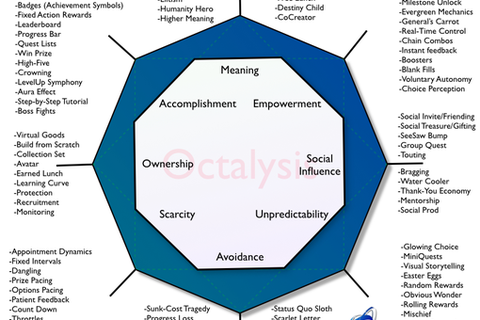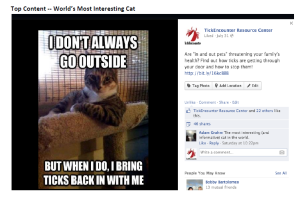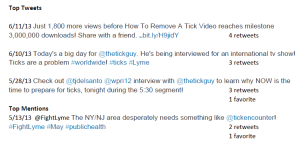Gamification via Octalysis – Not as tricky as it sounds
Again, this year’s South by Southwest Interactive festival united an astonishing group of innovative thinkers and strategists. One of those innovators was Yu-kai Chou, “a Gamification Pioneer (since 2003), International Keynote Speaker and Occasional Guest Lecturer for Stanford University,” according to his profile on the SXSW website. You can find more detailed information on his theories from Chou’s website, from which some of the information from this article was sourced, in addition to live attendance at the best session of the festival.
But what is Gamification?
Gamification enables companies to use game-like elements such as competition, point systems, challenges etc. to entice customers to use their product. It’s meant to make boring things seem fun, encouraging people to do what they might otherwise ignore.
- An example of explicit gamification is the Monopoly game at McDonalds.
- An implicit example would be the progress bar on LinkedIn profiles, showing what percentage of your profile is complete.
Volkswagen started a campaign on its “Fun Theory” to prove that making things fun encourages people to do them more often and therefore change their behavior. While gamification isn’t a new idea — think about every store that offers you cards to earn points or receipts that will enter you to win a prize if you fill out a survey — Chou offers a new way of looking at this strategy, and explains why some gamification plans fail, by describing his theory of Octalysis. This theory analyses eight types of motivations behind successful gamification.
Why does motivation matter in gamification?
This comes down to the difference between extrinsic and intrinsic motivation, meaning being motivated to do things by outside reward, compared to being internally driven. Understanding your consumers’ motivations is very important because intrinsic motivation can be snuffed out by trying to force extrinsic motivation on them.
- When customers are intrinsically (internally) motivated, they care about your product or service on their own.
- Extrinsic motivation, like a point system or other gamification technique, won’t matter to customers who aren’t interested in your product to begin with.
A good example of extrinsic motivation defeating intrinsic motivation is looking at students in school who are so concerned with grades that they fail to really learn the material beyond what they need to know for tests and assignments. Poor handling of motivation may be why, even though “70% of all Fortune 500 companies will be using gamification” according to Chou, “80% of these [gamification plans] will fail.”
How Octalysis can keep gamification from failing
Chou argues that simply incorporating gaming “elements” won’t get customers intrinsically motivated to use your product or service, and they simply won’t make a game interesting. In fact, gamification could turn people away, if it feels gimmicky. What will convince potential clients to use your brand, or to keep current customers coming back, is to think about how the gaming elements make them feel. Design games with a human-based, rather than function-based, focus – keep human motivation in mind.

Gamification Pioneer Yu-kai Chou’s model of effective gamification motivations, as presented at South by Southwest Interactive 2014.
Octalysis driven by 8 drivers
1. Meaning – The drive to be involved with something bigger than yourself, a community or a bigger purpose that drives decisions.
2. Empowerment – The motivation that drives people to paint or play with Legos. Expressing creativity and getting feedback is empowering and creates intrinsic motivation in players.
3. Social Influence – Includes drives such as competition, mentorship, companionship, acceptance, and envy.
4. Unpredictability – Comes into play with gambling at bCasino or http://www.minionlinespiele.net/. When the result is unpredictable, it drives players to try to discover what will happen next.
5. Avoidance – The drive to avoid a bad consequence, such as admitting defeat or feeling if you don’t act now, you’ll miss an opportunity.
6. Scarcity – When things are rare, it increases the motivation to obtain it. For example, if in a game only a select few are awarded a special accomplishment, it would make the players try harder to be one of the few to achieve it.
7. Ownership – When a player feels like he or she owns something, the drive to improve upon that ownership motivates him or her to continue working toward a goal.
8. Accomplishment – The drive to overcome a challenge. This is the easiest motivation to design for, according to Chou. It’s important to stress the challenge, otherwise the reward received will be meaningless.
How to employ Gamification using Octalysis
Begin with how you want your potential customers to feel when engaged with your process and your company. The motivations you wish to emphasize and act upon will help you decide on the best gamification techniques to employ. But ideally, you would use almost all of these motivations since different people are motivated by different drives. After that, consider these four phases a customer will hopefully go through. It’s important to think about how you want your clientele to feel at each stage, showing participants the value of not only beginning your game but sticking with it. These stages include:
- Discovery – Value must be evident immediately or no one will begin the process.
- Onboarding – When a new participant begins to create a space for themselves in this new gaming community or situation.
- Scaffolding – In this stage, value is often achieved through customers’ actions. Their motive may be driven by the core values of accomplishment and empowerment.
- End Game (Veteran Retention) – This stage includes mentoring new players and improving the community.
You have the power to interest potential clients and keep your current customers interested in your product or service by employing techniques that will speak to their motivations and show them value every step of the way. No one really needs your particular brand of product, so according to Chou, you need to figure out how to make them want your specific brand.
[social_share style=”circle” align=”horizontal” heading_align=”inline” text=”What the heck is gamification through Octalysis? Learn and implement tips by @yukaichou ” heading=”Cool theories? Share with your followers!” facebook=”1″ twitter=”1″ google_plus=”1″ linkedin=”1″ pinterest=”1″ /]
Which of these tips would you use as a customer? As a business? Let us know what you think in the comments!
[cta id=”4824″ align=”none”]



